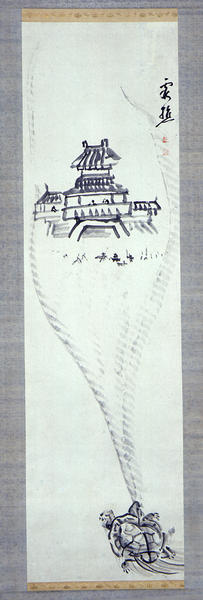竜宮図 池大雅筆
- 江戸時代
- 18世紀
- 紙本墨画
- H-117 W-33
解説(春の玉手箱)
江戸時代中期の文人画家、池大雅の竜宮図。竜宮は、龍神あるいは乙姫などが住む宮殿で、洞窟や川や海の奥底、あるいははるか海の彼方にあると考えられていた。南西諸島ではネリヤ、ニラヤ、沖縄ではニライカナイと呼ばれ、竜宮から椀を借りる「椀貸し伝説」は、中国やヨーロッパにも類似の物語がある。蛤が蜃気楼を吐く図柄は蒔絵などにもよく用いられるが、この図のように亀というのは珍しい。齢を経た亀が吐く蜃気楼に浮かび上がる竜宮図からは「浦島太郎」の昔話が連想されるが、海の神の住まいである竜宮と人間界の橋渡しの役目をしたのが、実は亀であるということを考えると面白い。蜃気楼の線に畳の跡が見受けられることから、何かの席中に求められ即興的に描かれた席画なのかもしれない。夢のある画である。
Catalogue Entry
This is the literati painter Ike no Taiga's rendition of the mythical dragon's palace. The dragon's palace, or the palace of the mythical princess, is often thought to exist on the far shore of the sea, or in the depths of grottoes, rivers or ocean. In Japan's Ryukyu Islands, these palaces are known as Neriya, or Niraya, or in Okinawa, as the Niraikanai. The famous tale of "borrowing a bowl" from the dragon's palace is a folk legend that exists in various forms in China and even Europe. Frequently the image of a mythical palace appearing in the vapor expelled by a clam is depicted in Japanese lacquer decoration, but rarely is a tortoise shown in this theme. Here the tortoise breathes forth the magical palace, and this also reminds us of the famous "Rip Van Winkle" like tale of Urashima Taro visiting the undersea palace. It is also fascinating to remember that it was the tortoise who became Urashima's vehicle from the land of mortals to the land of the undersea king. Traces of tatami mat patterns can be seen in the lines depicting the palace and this would seem to indicate that this painting may have been created at a party or other such impromptu setting. A painting of a dream‐like moment.
